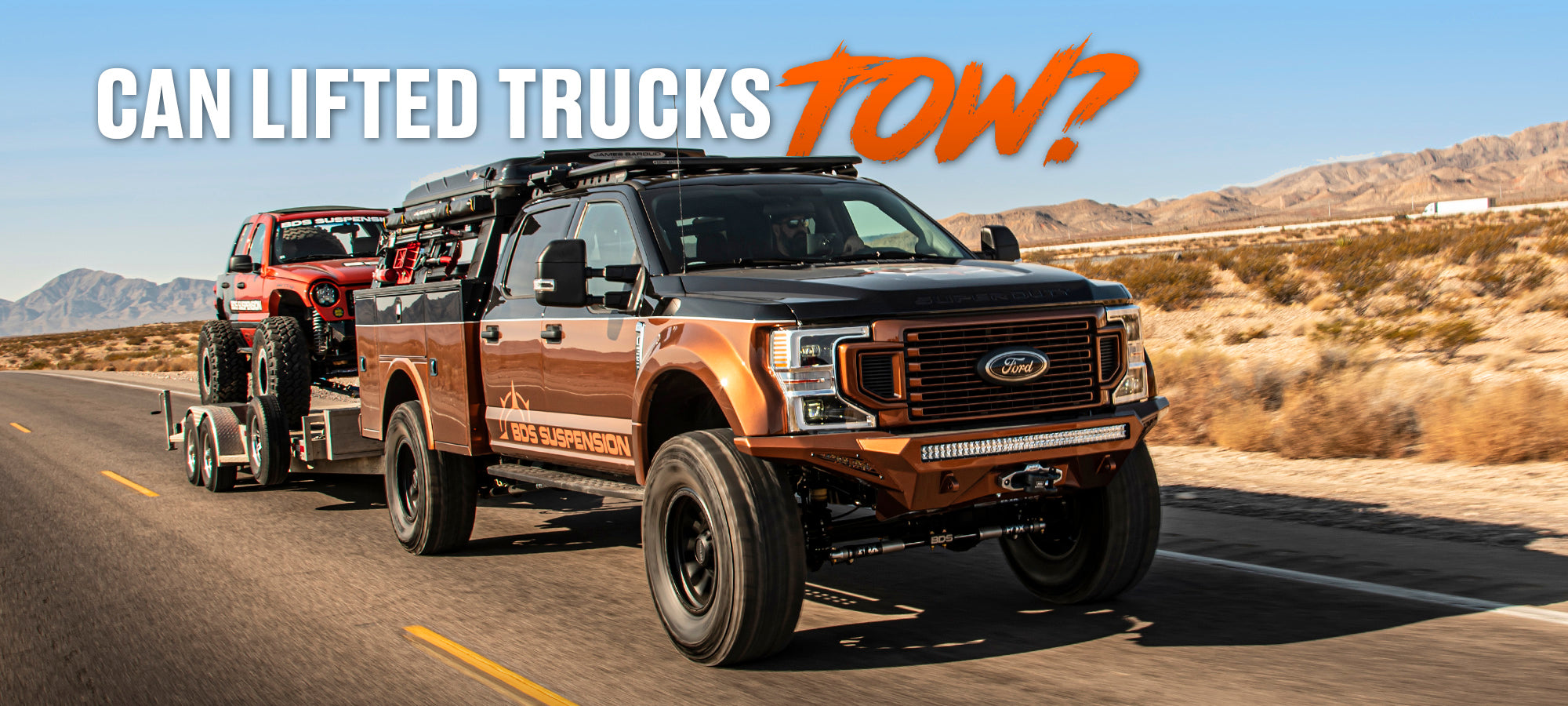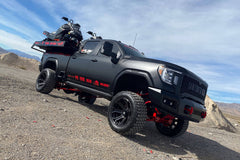Towing with a lifted truck: A guide

One of the common questions we get goes something like this “Will lifting my truck effect my tow capacity?” or “How tall can I lift my truck and still tow my gooseneck trailer?” or even “What will my tow capacity be after lifting my truck?” Well, to be honest those are all loaded questions that will require digging in for a better understanding of your particular needs. We get these questions most often with 3/4 and 1-ton (aka HD) truck owners, the real workhorses, but the topic comes up with 1/2-ton truck owners, Jeeps and just about anything with a hitch on it. Some of the things you’ll need to answer to point you in the right direction are questions like how big are you wanting to lift your truck, what wheel and tire package are you planning to use and what is the load rating, are you adding other mods (airbag, add-a-leaf, etc.) to help with weight distribution, and what are you trying to tow (trailer type and loaded weight)?
First question, Does lifting a truck affect tow capacity?
Likely yes, but to what extent depends on your setup. The fact of the matter is when lifting your truck you are raising the center of gravity as well as changing the steering and driveline angles. Installing a quality suspension lift like the one we offer here at BDS helps, they come complete, work within factory vehicle parameters and offer great on/offroad performance and handling. When installing larger tires/wheels you are adding more rotating mass to turn/stop. Adding a trailer to the equation piles on more weight and strain.

Suspension Configuration - One factor includes the configuration of your suspension - are you running a large rear lift block in the back or is there a replacement (taller) leaf spring? Typically the factory leaf springs, especially on HD trucks use a brawny multi-leaf design with integrated overload leaf to ensure plenty of load capacity. Adding a lift block and longer u-bolts is an acceptable way to net additional lift and retain the original spring’s load capacity, but taller lift blocks have the potential to “axle wrap” during heavy torque and hard launches. Adding a traction bar like the BDS Recoil Traction Bars can help control the rear axle for a wide range of driving conditions. With aftermarket leaf springs, they have more arch to achieve the lift without the need for a lift block. These leaf packs are designed to provide on-road comfort, offroad performance and oftentimes have an overload leaf built in for heavier loads. In the case of RAM 2500s with rear coil springs BDS offers a progressive rate coil spring to help provide additional spring rate the more the spring is compressed.

Shocks are another factor. Having a shock designed specifically for your application is critical, but even then the additional load can cause additional forces on the shock and not allow it to perform at their best. Shocks with compression adjustment like the FOX 2.5 Performance Elite (PE) series offer a larger aluminum body with reservoir that features high/low speed compression adjustments allow for increased fluid capacity, easy tunability, and faster cooling regardless of where you’re towing (on/off road).

Air Bags - One common upgrade to help with load capacity and towing stability are help airbags. There are a few options on the market and most will work with lifted applications (using factory springs) to allow you to air up the bags when you need them, and keep them uninflated for everyday use/comfort. One thing to note is for lifts with replacement leaf springs with more arch, modifications may be needed to install. Similarly add-a-leaf kits can be used to help stiffen up the leaf pack to help support additional weight, however these can’t be easily removed to retain factory ride quality when unloaded.

Tires/Wheels – Your tires are effectively your first point of suspension to absorb bumps in the road while providing traction and supporting the weight of the vehicle. Your vehicles original GVWR is contingent on the tires installed so if going from a 32” tall tire with a E load rating to a 37” tire with a D load rating there will be changes to both the handling of the vehicle due to the large sidewall, but also the lower load rating. Similarly wheels have a load rating, going larger, smaller, or wider than stock will have an effect on vehicle performance and overall load/tow capacity. Smaller wheels and more tire sidewall are great for aired down offroad, but not ideal for towing.

Gearing – If you are lifting your truck, installing larger wheels/tires and still running the factory gear ratio in the axles this will effect the overall performance as it will throw off the engine RPMs, transmissions shift points and cause more strain on the powertrain. Now we’re not saying it is a requirement to re-gear your truck if you plan to tow and depending on the difference in tire size you may still have acceptable driving/tow performance, but it is a factor to consider. There are several programmers on the market to help adjust shift points as well as tune to regain the perceived loss in engine performance caused by trying to turn the larger wheel/tire mass.
Second Question, Can I still tow my trailer?
This will depend on your particular situation. Are we talking about a TAG (tow behind), a 5th wheel (in bed) or gooseneck (in bed) trailer? Most trailers can accommodate some additional height from the vehicle towing it, but even that depend on the trailer. For TAG trailers, a drop hitch can be used to effectively tow the trailer. The main limitation you’ll find to lift height is how large of a drop hitch you have and what that hitch is rated for.
As you get into the realm of 5th wheel and gooseneck hitches, vehicle height is more critical as no one wants to take out a tailgate or bedside turning a sharp corner. Some trailers have adjustment to accommodate various hitch heights so there’s a good chance you’ll be able still use it once install a lift on your tow rig, however we suggest taking some measurements first to ensure you have clearance for the additional height from the lift kit and larger tire diameter you plan to install. Other factors will be if it is a tandem or tri-axle as you’ll want to maintain as level as possible of a trailer height.

Frequently Asked Questions
Can you hook a trailer to a lifted truck?
Absolutely, hooking a trailer to a lifted truck is entirely feasible. However, it's crucial to ensure that the lifted truck's suspension modifications, hitch, and trailer specifications are compatible and properly adjusted to guarantee safe and efficient towing operations.
Is it harder to tow with a lifted truck?
Towing with a lifted truck presents unique situations, yet it's not inherently more difficult. While the altered center of gravity due to the lifted suspension may necessitate adjustments in driving technique, modern suspension enhancements, such as upgraded shocks and stabilizers, can mitigate any challenges, offering a smoother towing experience even under demanding conditions.
Does a 4 inch lift affect towing?
Indeed, a 4-inch lift can influence towing performance. It's essential to consider that lifting a truck alters its geometry, potentially impacting factors like towing stability and weight distribution. However, advancements in suspension technology, coupled with proper setup and tuning, can minimize any adverse effects, ensuring that the lifted truck maintains its towing prowess even with the added height.
Why does my lifted truck sag when I tow?
The phenomenon of a lifted truck sagging during towing primarily stems from the redistribution of weight and the strain exerted on the suspension system by the added load. The lifted suspension may experience greater compression due to the increased leverage, leading to temporary sagging. Nonetheless, strategic suspension upgrades, such as heavy-duty springs and airbags, can effectively counteract this tendency, maintaining optimal ride height and stability while towing.
How much towing capacity do you lose with a lift?
The reduction in towing capacity resulting from a lift is contingent upon various factors, including the lift height, truck model, and suspension modifications. While lifting a truck may marginally affect its towing capacity due to changes in weight distribution and aerodynamics, proactive measures such as reinforcing the frame and upgrading the braking system can effectively mitigate any potential losses, allowing lifted trucks to confidently tackle towing tasks with minimal compromise.


